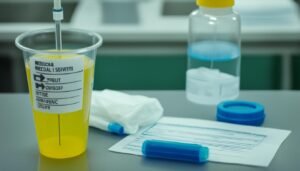Coagulase-negative staphylococci (CoNS) cause many bloodstream infections in tiny babies. This happens often in neonatal intensive care units.1 They are expert at forming biofilms on medical tools, which make them extra tough.1 Treating CoNS infections can be tricky, as regular antibiotic tests don’t work well.
We will look at the best antibiotics to treat CoNS UTIs, handling easy and hard cases. This way, you’ll know what to do if you face this challenge.
Key Takeaways
- Coagulase-negative staphylococci (CoNS) are a leading cause of bloodstream infections in very low birth weight infants in neonatal intensive care units.
- CoNS infections often fail to respond to antibiotic treatment due to their ability to form biofilms on medical devices.
- Effective antibiotic treatments for CoNS urinary tract infections (UTIs) must address both uncomplicated and complicated cases.
- Understanding the antibiotic resistance patterns of CoNS is crucial for selecting appropriate empiric and targeted therapy.
- Biofilm-specific susceptibility testing can provide more relevant information for guiding the treatment of CoNS infections.
Introduction to Coagulase-Negative Staphylococci
Coagulase-negative staphylococci (CoNS), mainly Staphylococcus epidermidis, often cause neonatal sepsis. They are a big problem in neonatal care units. The use of catheters in tiny babies greatly raises the risk of CoNS sepsis.2
Prevalence and Risk Factors
Human skin hosts at least 47 coagulase-negative staphylococci species3. Among these, S. epidermidis is the most common on skin and in infection samples. Adults can carry 10 to 24 strains of S. epidermidis on their skin.3 Having things like prosthetic material and a weak immune system ups the risk of getting a CoNS infection.2
Pathogenesis and Biofilm Formation
CoNS cause issues by making biofilms on surfaces like catheters. Once attached, bacteria make a protective layer. This layer lets them survive treatments meant to kill them. Thus, CoNS biofilms are hard to treat with antibiotics.2
Antibiotic Resistance in Coagulase-Negative Staphylococci
Coagulase-negative staphylococcal (CoNS) bugs are usually tough to fight with antibiotics. They’re not afraid of penicillin G (100%), gentamicin (83.3%), or oxacillin (91.7%).4 But luckily, they can’t stand against vancomycin (100%), ciprofloxacin (100%), and rifampicin (79.2%).4
These CoNS bugs are good at sticking together in biofilms. This makes them super hardy against antibiotics. Biofilms make the bugs 100 to 1000 times harder to kill.4 But, in a twist, bugs in biofilms might be less tough than single bugs when they’re not growing. This is important because it gives us clues on how to fight them.4
Some antibiotics need extra high doses to stop CoNS biofilms from forming.4 Strangely, oxacillin can make it easier for these bugs to build strong biofilms.4
These facts show how hard it is to treat CoNS infections with antibiotics. Especially if they’ve made biofilms. Knowing how this resistance works can help us find better ways to treat these infections.
Distinguishing Coagulase-Negative Staph Infections
It’s tough to tell if an infection is really from coagulase-negative staphylococci (CoNS) or just a contamination2. Doctors look at things like symptoms, where the sample was taken, and how many times the tests come back positive. CoNS infections can show up in different ways. They might cause blood, device-related, heart, bone, or urinary tract infections. The signs depend on the infection location and the person’s health.
Differentiating True Infection from Contamination
Spotting a real CoNS infection from a false alarm is tricky2. This is because CoNS usually live on our skin. Doctors consider the patient’s symptoms, where the sample came from, and how many tests turned up positive.
Clinical Manifestations of CoNS Infections
CoNS infections can look very different. They might cause bloodstream infections, heart, endocarditis, or bone infections1. Symptoms change based on the infection site and the health of the person. They can include fever, chills, or swollen spots.
| Clinical Manifestation | Characteristics |
|---|---|
| Bloodstream Infections | Fever, chills, low blood pressure, and other signs of a body-wide infection. Tend to be linked with medical devices inside the body.1 |
| Device-Related Infections | You might see red, swollen, and painful skin near a device. This can ruin the device and it might need to be taken out.1 |
| Endocarditis | Fever, unusual heart sounds, and signs of a heart valve infection. Might be linked to past heart issues or a fake heart valve.1 |
| Urinary Tract Infections | Pain or a strong need to pee can signal a urinary infection. May be linked to having a tube in your bladder or other tools.1 |
| Osteomyelitis | A spot that’s sore and puffy might be a bone infection. This can happen near a fake joint or after an injury or surgery.1 |
Antibiotic Treatment Guidelines
For simple coagulase-negative staphylococci (CoNS) urinary tract infections (UTIs), doctors start antibiotics. They choose medicines that are usually the best at fighting off common bacteria.1 Doctors pick the best treatment by watching how patients respond and checking what’s growing in their urine.
Empiric Treatment for Uncomplicated UTIs
For straightforward CoNS UTIs, nitrofurantoin is often used. It’s taken twice a day for five days. Another good option is trimethoprim-sulfamethoxazole, which is also taken twice a day but for just three days.5 These treatments work well against the usual suspect, Staphylococcus saprophyticus. This type of bacteria is a big cause of UTIs in young women.5
Treatment for Complicated UTIs
Complex CoNS UTIs, like those linked with catheters or birth issues, need a closer look. Doctors will choose antibiotics aimed at the exact bacteria causing the infection.5 They make this decision after the lab tests the patient’s urine. Some people may need extra care, like IV antibiotics, if their health is not stable or if they have certain complications. This happens while doctors check how bad the infection is using images of the inside of the body.5
It’s essential to remember that Staphylococcus saprophyticus can resist some common antibiotics. These are the same ones often used to treat Escherichia coli-related UTIs. Medications like ampicillin, ceftriaxone, cephalexin, and ciprofloxacin may not work against it.5 Knowing which antibiotics are already overused and which ones are still effective in your area helps doctors choose the best treatment for CoNS UTIs.
Antibiotic Susceptibility Testing
Testing Coagulase-negative staphylococci (CoNS) for antibiotic susceptibility uses a known method. It’s called the Clinical and Laboratory Standards Institute (CLSI) method. This method gives details on how well various antibiotics can stop the bacteria’s growth.4
Standard Susceptibility Tests
Yet, the common tests might not fully show how well antibiotics work on CoNS when they form biofilms. When CoNS grow in biofilms, they might be harder to treat. A test called the minimum biofilm eradication concentration (MBEC) assay helps more with these cases. It looks at what antibiotics can effectively fight biofilm CoNS.4
Biofilm Susceptibility Testing
In research, certain CoNS strains were highly resistant to some antibiotics but not others. They were tough against penicillin G (100%) and gentamicin (83.3%), but very sensitive to vancomycin (100%).4
Most studies found that bacteria in biofilms were much more resistant compared to when they were not in biofilms. They were up to 100-1000 times harder to treat. In later stages of biofilm infections, the MBEC level is a key measure. It’s better at guessing the clinical outcome than the MIC level.4
Some antibiotics at low doses made CoNS create biofilms better. Among 24 CoNS strains taken from very small newborns’ blood, antibiotic response varied with the strain type. Each species had its unique response.4
what antibiotics treat coagulase-negative staph uti
First-Line Antibiotics for CoNS UTIs
The best antibiotics for coagulase-negative staphylococci (CoNS) UTIs depend on local antibiotic resistance. Doctors often start with vancomycin, daptomycin, linezolid, or trimethoprim-sulfamethoxazole.1 They also look at the patient’s health and any past antibiotic use when choosing a treatment.
Alternative Antibiotic Options
If the first antibiotics don’t work, other options include fluoroquinolones, rifampin, fosfomycin, or using more than one antibiotic.4 Doctors choose these based on the CoNS bacteria’s specific resistance.
Antimicrobial Resistance Concerns
Coagulase-negative staphylococci (CoNS) are becoming resistant to antibiotics. This means standard treatments may not work well against them.1 They resist antibiotics by making enzymes that deactivate them, changing the antibiotics’ target sites, and by forming biofilms.1
Mechanisms of Antibiotic Resistance
Types of CoNS, like Staphylococcus epidermidis and Staphylococcus haemolyticus, are showing high resistance. For example, Staphylococcus epidermidis is highly resistant to penicillin (97%) and oxacillin (64.7%).6 Staphylococcus haemolyticus is also hard to treat, resisting penicillin (96.2%), ciprofloxacin (72.3%), and gentamicin (72%).6 These high rates of resistance make treating CoNS infections, like UTIs, very difficult.6
Strategies to Combat Resistance
Combating antimicrobial resistance in CoNS infections requires a comprehensive approach. It involves using multiple antibiotics together, creating new drugs, and finding ways to fight biofilms.1 Better infection control and managing antibiotic use more carefully can also slow the spread of resistant CoNS strains.1
Biofilm-Related Challenges in Treatment
The extracellular matrix of CoNS biofilms stops antibiotics from getting through.4 The slow growth of bacteria inside biofilms makes them harder to kill with antibiotics. This makes treating CoNS infections very hard.
There are also persister cells in CoNS biofilms, which are alive but not growing. They can survive antibiotics.4 These cells can also wake up, making infections come back again. The biofilm can even break apart, releasing more bacteria into the body.
Antibiotic Penetration and Tolerance
The matrix of CoNS biofilms doesn’t let antibiotics pass through well.4 Since the bacteria inside grow slowly, they don’t get killed by antibiotics easily. This adds to the challenge of treating these infections.
Persister Cells and Biofilm Dispersal
In CoNS biofilms, there are survivable persister cells.4 These cells can come back after antibiotics are used. This can lead to infections coming back. Also, the biofilm can break and release more bacteria, making infections harder to treat.
Prevention and Management Strategies
It’s key to use effective infection control measures. These include good hand hygiene, wearing the right personal protective equipment, and always using clean techniques. This is especially important in places like NICUs.7 Some people are more at risk of getting CoNS infections. This includes those with weak immune systems, anyone with a urinary catheter, patients with IV lines, and those who had joint surgery.7
Catheter Management
Managing catheters the right way helps lower CoNS infection risks. This means taking them out or changing them as needed.7 CoNS infections are hard to fight because many bacteria strains are now resistant to antibiotics. This makes fighting these infections with medicine tricky.7
Special Considerations in Neonates and Pediatrics
In babies and kids, picking the right antibiotics for infections from [12] coagulase-negative staphylococci (CoNS) is tricky. They have young kidneys that can’t filter meds well. Also, we worry about side effects and how drugs affect their good bacteria.8
Antibiotic Selection and Dosing
Babies and children are not just small adults. So, we need a special plan for antibiotics against [12] CoNS infections for them. They clear drugs slower and process them differently. We have to think about if a medicine might hurt their development.8
Challenges in Neonatal Intensive Care Units
Neonatal intensive care units (NICUs) are full of risks. They use a lot of devices and young babies are very fragile there. This makes fighting [12] CoNS infections hard.8 Preemies catch diseases more easily. Problems can get worse fast, and we have few ways to treat them. So, we must be very careful with how we handle infections and pick the right medicines in these special places.
Future Directions and Research Needs
Antibiotic resistance and biofilm formation are big problems against Coagulase-Negative Staphylococci (CoNS). To help fight these, scientists look for new ways to kill bacteria and better ways to find or confirm the infection.1
Novel Antimicrobial Approaches
There are new methods being studied to fight CoNS, including anti-biofilm compounds and using bacteriophages, which are viruses that can kill bacteria. These new ways are trying to do better than regular antibiotics, especially against bacteria that form biofilms.1
Improving Diagnostic Tools
Fast ways to identify bacteria and to test their biofilm abilities can help a lot. It can make figuring out the infection correct faster. Also, it could help doctors choose the best drugs to treat it, leading to better outcomes for patients.7
Conclusion
Coagulase-negative staphylococci (CoNS) cause many urinary tract infections. They often affect people who are at higher risk, including those with medical tools inside them and newborns.9 It’s hard to treat these infections because the bacteria make a protective layer and resist many drugs.4
CoNS stick together to form strong layers that protect them from medicines. This makes them up to a thousand times harder to kill.4 And now, there are types of these bacteria that are not affected by methicillin. That means they can fight off more drugs too.9 But scientists are working on new ways to fight these germs, like using special medicines or better tests.4
To fight these CoNS better, doctors and nurses are learning more about them. They are looking at ways to stop the infections before they happen. This helps make sure people with these infections get the best care possible.419
FAQ
What are the common causative agents of coagulase-negative staphylococcal urinary tract infections (CoNS UTIs)?
How do CoNS infections differ from other UTIs?
What are the challenges in diagnosing true CoNS infections?
What are the first-line antibiotics used for empiric treatment of uncomplicated CoNS UTIs?
How does antibiotic susceptibility testing for CoNS differ from standard methods?
What are some of the mechanisms of antibiotic resistance in CoNS?
What are the unique challenges in managing CoNS infections in neonates and pediatric patients?
What are some of the novel approaches being explored to combat CoNS infections?
Source Links
- https://www.ncbi.nlm.nih.gov/pmc/articles/PMC8070739/
- https://www.uptodate.com/contents/infection-due-to-coagulase-negative-staphylococci-treatment
- https://dermnetnz.org/topics/coagulase-negative-staphylococci
- https://www.ncbi.nlm.nih.gov/pmc/articles/PMC2902406/
- https://www.ncbi.nlm.nih.gov/books/NBK482367/
- https://www.ncbi.nlm.nih.gov/pmc/articles/PMC6210844/
- https://www.healthline.com/health/coagulase-negative-staph
- https://www.ncbi.nlm.nih.gov/pmc/articles/PMC3674645/
- https://www.sciencedirect.com/topics/immunology-and-microbiology/coagulase-negative-staphylococcus




